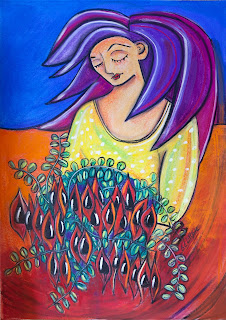Of course there is a huge difference between the more expensive pastels and the cheaper variety but all can be useful.
The biggest challenge for me has been finding the right colours and generally pure pigment and very bright colours.
Sometimes the pure pigment pastels are very soft and flakey and I have often wondered what ingredient holds the pigment together so that I could restore those that "fall apart".
During some quiet time in the hot weather (and we have been hot this summer.. up to 50C so no use venturing outside after about 8.30 in the morning) I began researching how pastels are made.
The most interesting information came from Kurt Wenner's blog https://kurtwenner.com/blog/2012/09/01/creating-pastels/ where a range of recipes are offered.
The main binder ingredient suggested is gum tragacanth although wallpaper paste is also suggested as a cheaper option.
It was the description about how the gum is dissolved that seemed really familiar and made me think back to past experiences.
"Once the powder is dispersed in the alcohol, add the mixture to a container with 10 parts water. The water should be churning in a blender or mixer as the gum solution is added. The gum likewise needs to be stirred while in the alcohol solution or it will settle to the bottom of the container.
3. Stir the mixture occasionally, but do not let it froth. It is best to let the solution sit for 8-12 hours before using it. The resulting liquid should be thick and slimy, but easily pourable. The binding strength will need to be tested, so the initial result is not extremely important."
Once upon a time I was a "marbler" https://www.flickr.com/photos/georgiesharp/albums/68969
We used Carageen to create a gelatinous, watery base for our marbling process and this was mixed in a similar fashion to the above description and allowed to sit over night.
I have several containers of Carageen left over from this past life and so with nothing to lose I set about experimenting.
Main ingredients:
Carageen - mixed in water
Calcium carbonate
Pigment
I tried several ways of mixing the ingredients according to the recipes I found.
Rolling in plastic wrap produces a cylinder shape.

Leaving the mixture in ice block trays to dry out resulted in cracking but the pastel pieces work just as well as the rolled ones.
The next step was to mix the pigment, some calcium carbonate and the glue in small containers but as the block began to dry I levered it away from the edge and no cracking occurred.




















